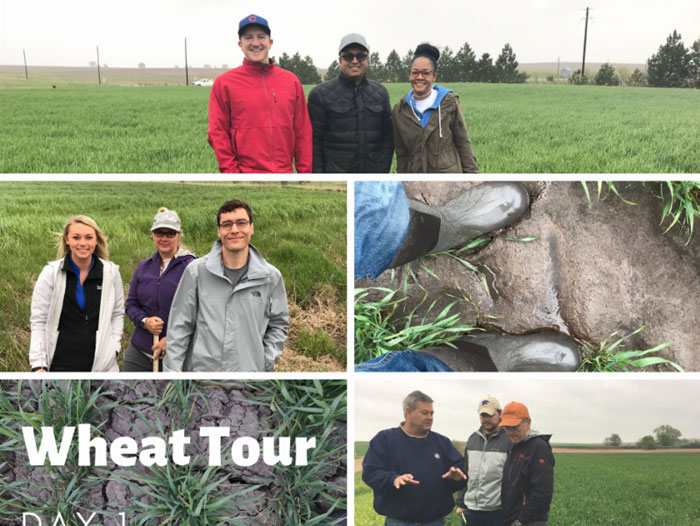Kansas Wheat Tour: Day 1 Wrap-Up
May 1, 2019 | 3 min to read

More than 75 people from 25 U.S. states and 3 other countries traveled on six routes between Manhattan and Colby, Kan., Tuesday, stopping at wheat fields every 15-20 miles along the routes, as part of the Wheat Quality Council’s 2019 Hard Winter Wheat Tour.
Many tour participants had never stepped foot in a wheat field before and had only seen these Kansas plains from the window seat of passing airplane. These are the millers, bakers, food processors and traders who buy the wheat that Kansas farmers grow. If these fields make it to harvest, the resulting crop will go into breads, but also a number of other food items, from snack cakes to donuts to seasonings, batters and coatings for fish, chicken and appetizers.
Wheat industry professionals from all over the world have gathered in America’s Breadbasket, including Claire Hutchins, market analyst for U.S. Wheat Associates. Hutchins grew up on an irrigated wheat, soy and alfalfa farm near Fruita, Colorado. Her employer, U.S. Wheat Associates, is an export market development organization providing information and technical services to American farmers’ overseas customers, including some on this trip.
“U.S. Wheat Associates educates foreign customers about the quality of U.S. wheat,” said Hutchins. “It’s important to communicate with buyers about the future of the crop. If they’re looking at protein purchases, we can get an idea of the protein potential of this crop and help them optimize their purchase decisions.”
Every tour participant makes yield calculations at every stop based on three different area samplings per field. These individual estimates are averaged with the rest of their car mates, and eventually added to a formula that produces a final yield estimate for the areas along the routes. While yields tend to be the spotlight of the Wheat Quality Tour, the real benefit is the ability to network among the ‘grain chain.’ This tour gives Kansas farmers the chance to interact with and influence their customers around the globe, on the tour, as well as at the #wheattour19 hashtag.
“What’s really interesting right now is being able to see such variability, not only from county to county, but from field to field,” said Hutchins. “We’re seeing gorgeous fields, but we are also seeing a lot of fields that are really stressing. You can even tell the differences as you’re passing by on the road. It’s really valuable to be able to witness first hand some of the issues our farmers have to face to produce a crop. It allows us to put the knowledge we had into a tangible, real world experience.”
Tuesday’s 20 cars of wheat tour scouts made 240 stops at wheat fields across north central, central and northwest Kansas, and into southern counties in Nebraska. The calculated yield is based on what scouts saw at this point in time. The crop is behind schedule in terms of development, and a lot can happen between now and harvest. The calculated yield from al l cars was 46.9 bushels per acre.
Currently, winter wheat condition is rated 3 percent very poor, 8 poor, 31 fair, 48 good, and 10 excellent. Winter wheat jointed was 64 percent, ahead of 50 last year, but behind 75 average. Headed was 4 percent, near 2 last year, but behind 22 average.
Hutchins is one of three representatives of USW. Also traveling with the group are Erica Oakley, director of programs, and Elizabeth Westendorf, assistant director of policy.
“We are on the tour to see what the new crop looks like versus last year’s crop to educate customers about the timing of their purchase decisions,” said Hutchins. “Personally, I come from an irrigated farm, so I’m on this tour to help myself understand the volatility of growing conditions of dryland wheat. I want to learn more to work with traders.”
In addition, scouts from Nebraska and Colorado met the group in Colby, Kansas, to give reports from their states. The estimate for the Nebraska wheat crop is 47.4 million bushels, down from 49.5 million bushels last year. The estimated yield average is 44 bushels per acre. In Colorado, the estimated yield was 46.5 bushels per acre. Production in Colorado is estimated at 97.2 million bushels, up from 70.5 million bushels last year.
Wheat Tour 19 continues Wednesday with six routes between Colby and Wichita, Kan.
